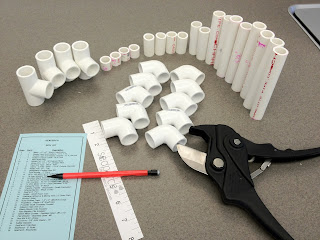Week 10
For the last few weeks the main task to complete were finishing up the data collection, making the powerpoint presentation, and writing the final report. However, in the process of finishing up the model, there was an error in receiving the correct sensor that we originally ordered. The final look of the Sea perch that we created looked like this:
The figure above shows the final look of our Sea perch, which we had to built in a base made out of Azec board to attach the syringe to an ordinary Sea perch. In order to activate the syringe to collect water, we needed a motor. Just as we operated the motor on the control box, we added on a switch to automatically pull the syringe out to collect the water sample. Wooden spool with a v-groove was glued on to the shaft of the motor which was connected to a fishing line and then tied on to the end of the syringe.
the mounted syringe on Azec Board
Motor connected to one-way switch
Wooden spool with v-groove.
The goal we set for this project earlier in the term was to get samples of water in different depths and measure the pH using pH paper and depths using a depth sensor. However only partial work was able to be complete due to erroneously sent pressure sensor. The way that the pressure sensor was supposed to work was to detect the pressure value in a certain depth in water and then afterwards find the h-height value of placement of sea perch using the formula P=ρ*g*h
Where:
P-pressure
ρ-rho, density of fluid ( pool water)
g-gravity
h-height/depth in water
h=P/ρ*g
However the malfunctioning pressure sensor did not let us get the value of h, which was the height or the depth in water.
We have called in to exchange for a new sensor, but due to time constraint, no further progress was possible. If the time would have allowed it, we would have been able to find out the depths using the pressure sensor and we would have thoroughly complete the task we designed in the project. If the depth of the water were determined as we hoped in the beginning, more and further analysis would have been possible.
Where:
P-pressure
ρ-rho, density of fluid ( pool water)
g-gravity
h-height/depth in water
h=P/ρ*g
However the malfunctioning pressure sensor did not let us get the value of h, which was the height or the depth in water.
We have called in to exchange for a new sensor, but due to time constraint, no further progress was possible. If the time would have allowed it, we would have been able to find out the depths using the pressure sensor and we would have thoroughly complete the task we designed in the project. If the depth of the water were determined as we hoped in the beginning, more and further analysis would have been possible.












